แนวทางการบูรณาการโครงการชุมชนท่องเที่ยวนวัตกรรม OTOP นวัตวิถี จังหวัดนครนายก Guidelines for Integrating OTOP Innovative Community Tourism Projects in Nakhon Nayok Province
Main Article Content
บทคัดย่อ
แนวทางการบูรณาการโครงการชุมชนท่องเที่ยวนวัตกรรม OTOP นวัตวิถี กับการพัฒนาและส่งเสริมการท่องเที่ยวเชิงสร้างสรรค์จังหวัดนครนายก เป็นการดำเนินการที่สำคัญยิ่งเพราะเมื่ออุตสาหกรรมการท่องเที่ยวเชิงสร้างสรรค์ด้านโครงการชุมชนท่องเที่ยวนวัตกรรม OTOP นวัตวิถี ส่งผลต่อประเทศไทย รวมถึงยังสามารถใช้เป็นเครื่องมือในการประชาสัมพันธ์เพื่อดึงดูดนักท่องเที่ยวทั้งชาวไทยและนักท่องเที่ยวจากทุกมุมโลก เกิดความหลงใหลและต้องการเดินทางมาสัมผัส สถานที่ท่องเที่ยวในประเทศไทยมากยิ่งขึ้น โดยมีวัตถุประสงค์เพื่อศึกษา 1) แนวทางการบูรณาการโครงการชุมชนท่องเที่ยวนวัตกรรม OTOP นวัตวิถี จังหวัดนครนายก 2) ส่งเสริมให้นครนายกเป็นชุมชนท่องเที่ยว OTOP นวัตวิถี ใช้วิธีการวิจัยเชิงคุณภาพ โดยการสัมภาษณ์เชิงลึกผู้ที่เกี่ยวข้องแบบเฉพาะเจาะจงจากตัวแทน จำนวน 20 ชุมชน 4 อำเภอ มีผู้ให้ข้อมูลรวม 5 กลุ่ม จำนวนทั้งสิ้น 25 คน วิเคราะห์ผลโดยใช้แบบสัมภาษณ์แบบกึ่งโครงสร้างและประชุมกลุ่มย่อย วิเคราะห์ข้อมูลโดยใช้เทคนิคการวิเคราะห์เนื้อหา
ผลการวิจัย พบว่า 1) แนวทางการบูรณาการโครงการชุมชนท่องเที่ยวนวัตกรรม OTOP นวัตวิถี จังหวัดนครนายก ในภาพรวมจากผลการสัมภาษณ์ผู้มีส่วนได้ส่วนเสียทั้ง 5 กลุ่ม มีความเห็นเรื่องของการพัฒนาและส่งเสริมการท่องเที่ยวเชิงสร้างสรรค์ โดยเฉพาะการพัฒนาคุณภาพของผลิตภัณฑ์ หรือสินค้า OTOP ให้มีมาตรฐาน ปรับปรุงภูมิทัศน์ตามแหล่งท่องเที่ยวต่าง ๆ ให้มีสิ่งอำนวยความสะดวกครบครัน มีมาตรฐาน เพียงพอต่อนักท่องเที่ยว 2) พัฒนาส่งเสริมกิจกรรมเชิงสร้างสรรค์ในแต่ละชุมชน ให้เหมาะสมกับนักท่องเที่ยวในทุกช่วงวัย ต้องพัฒนาการโฆษณาการทำการตลาดในการประชาสัมพันธ์ชุมชนท่องเที่ยว OTOP นวัตวิถีของจังหวัดนครนายก ทั้ง 20 ชุมชน 4 อำเภอในทุก ๆ แพลตฟอร์มให้สามารถเข้าถึงได้ง่าย และแนวคิดในการสร้างโมเดลทางการท่องเที่ยว “OTOPNEOTOUR” เป็นกรอบในการดำเนินแนวทางการบูรณาการโครงการชุมชนท่องเที่ยวนวัตกรรม OTOP นวัตวิถี จังหวัดนครนายก นำมาประยุกต์ใช้กับการท่องเที่ยวภายในชุมชนท่องเที่ยว OTOP นวัตวิถีในจังหวัดอื่น ๆ ได้
Article Details

This work is licensed under a Creative Commons Attribution-NonCommercial-NoDerivatives 4.0 International License.
References
ฉลองศรี พิมลสมพงศ์. (2555). การท่องเที่ยว: มิติแห่งศาสตร์บูรณาการ. วารสารวิทยาการจัดการและสารสนเทศศาสตร์ มหาวิทยาลัยนเรศวร, 7(1), 1–14.
ชุษณะ เตชะคณา. (2565). รูปแบบสมการโครงสร้างเพื่อการพัฒนาและส่งเสริมการท่องเที่ยวเชิงสร้างสรรค์ในประเทศไทย. Journal of Positive School Psychology, 6(4), 7730–7740.
ธวัชชัย สุวรรณสาร. (2556). ยกระดับแบรนด์ ด้วยการสร้างคุณค่าให้แบรนด์ของคุณ. สืบค้นเมื่อ 20 ธันวาคม 2567, จาก http://www.coachtawatchai.org/2013/08/blogpost_18.html.
ประภาพร แสนโคตร, & พีรสิทธิ์ คำนวณศิลป์. (2563). ผลการดำเนินงานโครงการชุมชนท่องเที่ยว OTOP นวัตวิถี จังหวัดมหาสารคาม. Journal of Graduate MCU KhonKaen Campus, 7(4), 299–310.
เพ็ญโสภา ปิ่นพงศา. (2554). องค์ประกอบของผลิตภัณฑ์และความตระหนักรู้ (Brand Awareness) ในตราสินค้าที่มีผลต่อการตัดสินใจซื้อเครื่องดื่มชูกำลัง เอ็ม 150 ของผู้บริโภคในเขตกรุงเทพมหานคร. การศึกษาเฉพาะบุคคลปริญญามหาบัณฑิต, มหาวิทยาลัยกรุงเทพ.
เสรี วงษ์มณฑา. (2542). กลยุทธ์การตลาด. กรุงเทพฯ: บริษัท ธีระฟิล์มและไซเท็กซ์ จำกัด.
เสรี วงษ์มณฑา, & วรสุวิทย์ โพธิสัตย์. (2561). แนวทางในการเสริมสร้างคุณค่าสินค้า OTOP และการใช้ประโยชน์จากทรัพยากรการท่องเที่ยวเพื่อพัฒนาเศรษฐกิจชุมชน: กรณีศึกษา อำเภอศรีสวัสดิ์ จังหวัดกาญจนบุรี. วารสารรัชต์ภาคย์, 12(25), 1–24.
แสงทิพย์ พรหมอักษร. (2564). ข้อเสนอแนะการปรับเปลี่ยนแนวทางการดำเนินงานกรมการพัฒนาชุมชนเพื่อให้ส่งเสริมบทบาทของชุมชน กรณีศึกษา การดำเนินงานโครงการชุมชนท่องเที่ยว OTOP นวัตวิถี. การค้นคว้าอิสระ ร.ม., มหาวิทยาลัยธรรมศาสตร์, กรุงเทพฯ.
Kotler, P., & Keller, K. L. (2012). Marketing management (14th ed.). Pearson Education.

